Gigabyte Z77-HD4 Review
by Ian Cutress on May 19, 2013 10:00 AM EST- Posted in
- Motherboards
- Gigabyte
- Z77
Rightmark Audio Analyzer 6.2.5
In part due to reader requests, we are pleased to include Rightmark Audio Analyzer results in our benchmark suite. The premise behind Rightmark:AA is to test the input and output of the audio system to determine noise levels, range, harmonic distortion, stereo crosstalk and so forth. Rightmark:AA should indicate how well the sound system is built and isolated from electrical interference (either internally or externally). For this test we connect the Line Out to the Line In using a short six inch 3.5mm to 3.5mm high-quality jack, turn the OS volume to 100%, and run the Rightmark default test suite at 48 kHz, 96 kHz and 192 kHz. We look specifically at the Dynamic Range of the audio codec used on board, as well as the Total Harmonic Distortion + Noise.
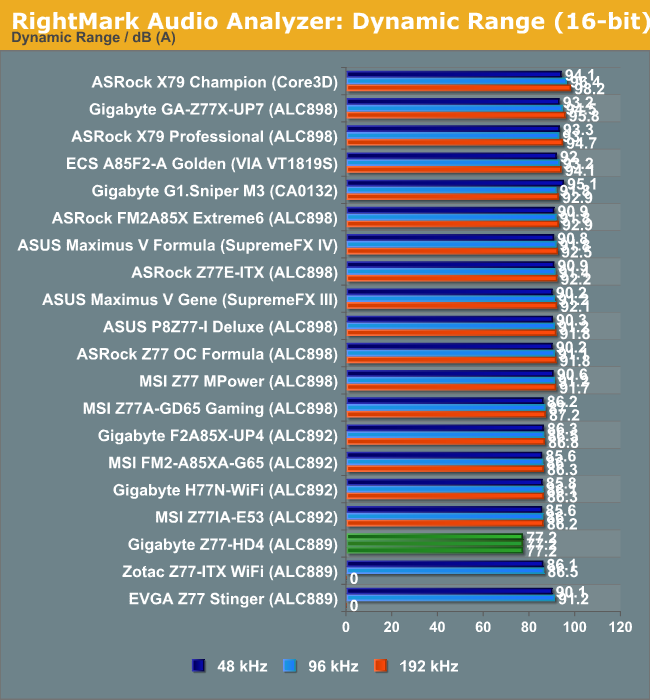
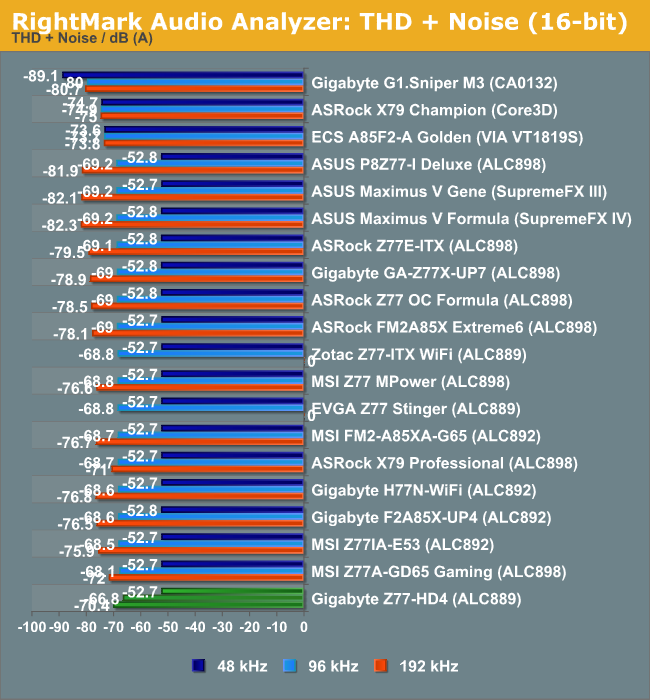
With the price of the board, we get one of the cheaper Realtek audio options. It performs worse in our testing than the ALC89x and above, but is able to pass our 192 kHz test unlike the ALC889 mITX versions.
USB 3.0 Backup
For this benchmark, we run CrystalDiskMark to determine the ideal sequential read and write speeds for the USB port using our 240 GB OCZ Vertex3 SSD with a SATA 6 Gbps to USB 3.0 converter. Then we transfer a set size of files from the SSD to the USB drive using DiskBench, which monitors the time taken to transfer. The files transferred are a 1.52 GB set of 2867 files across 320 folders – 95% of these files are small typical website files, and the rest (90% of the size) are the videos used in the WinRAR test.
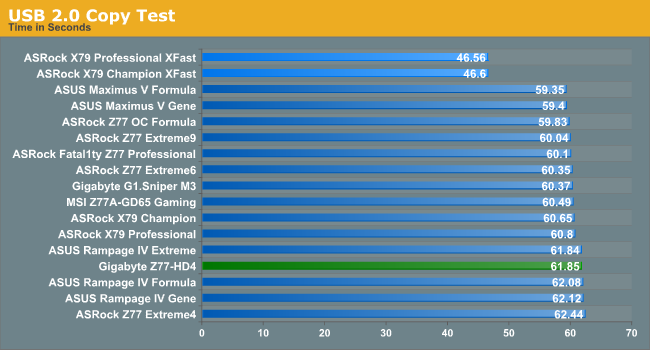
USB 2.0 performance is middling, on the wrong side of 61 seconds but only a fraction worse than the top non-XFast score.
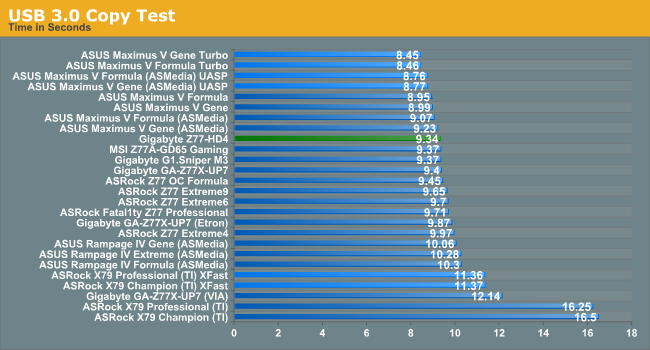
By contrast, the USB 3.0 performance is nearer the sharp end, despite sequential write speeds not being the best.
DPC Latency
Deferred Procedure Call latency is a way in which Windows handles interrupt servicing. In order to wait for a processor to acknowledge the request, the system will queue all interrupt requests by priority. Critical interrupts will be handled as soon as possible, whereas lesser priority requests, such as audio, will be further down the line. So if the audio device requires data, it will have to wait until the request is processed before the buffer is filled. If the device drivers of higher priority components in a system are poorly implemented, this can cause delays in request scheduling and process time, resulting in an empty audio buffer – this leads to characteristic audible pauses, pops and clicks. Having a bigger buffer and correctly implemented system drivers obviously helps in this regard. The DPC latency checker measures how much time is processing DPCs from driver invocation – the lower the value will result in better audio transfer at smaller buffer sizes. Results are measured in microseconds and taken as the peak latency while cycling through a series of short HD videos - under 500 microseconds usually gets the green light, but the lower the better.
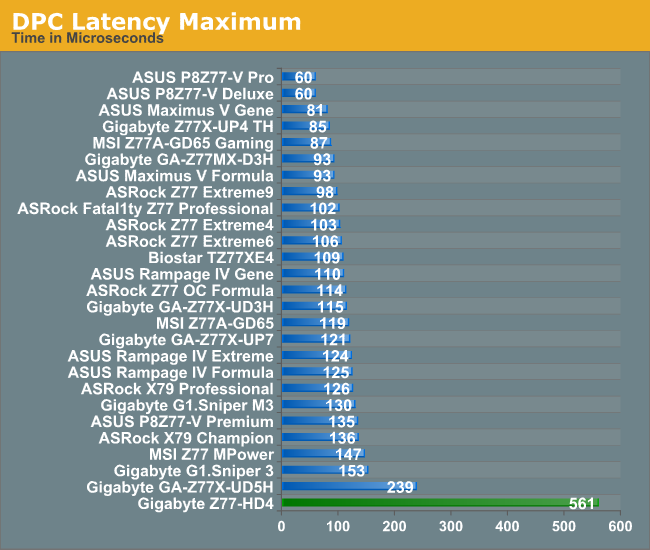
A major realisation of having that un-optimised BIOS is perhaps shown best in the DPC. To start, with the default install, the monitoring features of ET6 causes the DPC to peak at over 800 microseconds. Disabling this software causes a maximum of around 114 microseconds, although every so often we encountered a peak of around 300-500 microseconds, and 561 was recorded as the highest peak.










63 Comments
View All Comments
lmcd - Sunday, May 19, 2013 - link
I'm just going to tell you now that your assessment is completely off -- a good amount of people can tell the difference in regards to the audio. Plenty of people like the option to XF/SLI later in custom builds. And some of those performance differences were shocking. That was an audio demonstration, but could mouse polling face that, too?Anyway, don't get me started on the audio, but there is reason for better solutions than this board.
HardwareDufus - Monday, May 20, 2013 - link
the "this board is probably aimed at the internet café market in China" is pretty shameful and below the belt Ian..I agree as well... Don't be so elitest! It's refreshing to see a decent $120 motherboard that sacrifices nothing that 95% of buyers require. Ian you are getting spoiled reviewing too many high end motherboards jammed with features that only 2% of the buyers require. Come down out of the stratosphere and join the rest of us.
kmmatney - Monday, May 20, 2013 - link
I also think this comment was way off ""this board is probably aimed at the internet café market in China"If anything, the board is for this market:
http://www.microcenter.com/site/brands/intel-proce...
And its what I build for myself, friends, family, and all the computers I build for my company, and anyone else who wants a great gaming experience without breaking the bank.
Razorbak86 - Monday, May 20, 2013 - link
"Shameful" and "below the belt"? o.ODo you always get your panties in a twist over such innocuous opinions?
/seewhatididthere
kmmatney - Sunday, May 19, 2013 - link
I have to admit I never use the on-board buttons on my motherboard, and find beep codes to be just as useful as an error code display. At the end of the day, you still need to swap out parts to troubleshoot an error, regardless of an error code display.Flunk - Monday, May 20, 2013 - link
I agree with you I can't see a need for onboard power and reset switches on any motherboard. If the computer is set up they're worthless and if you're working on it you have your screwdriver right there to short out the front panel header. There really is no need at all for onboard power buttons.jabber - Monday, May 20, 2013 - link
I have to agree. I don't need dragons or ninjas on the box.I don't need heatsinks fashioned in some faux novelty bullet or landmine design.
I don't need LED lit BIOS reset buttons (I've used mine twice in 5 years, so no, not needed).
I don't need LED error notifications. I've had them and never needed them.
I don't need umpteen video out options, I have a GPU card.
I don't need built in audio, I have a sound card.
I don't need built in ethernet, I have a Intel CT nic.
I don't need a PS2 socket.
I don't need more then 4 SATA ports (three if I'm honest is all I ever need)
I don't need extra USB/Serial/Firewire expansion on the board.
I don't need glow in the dark sockets or custom motherboard colours.
I don't need 8 fan controller sockets.
What do I need? A good quality stripped down board that without all that unnecessary crud would probably cost $50. Unfortunately no one seems to think anyone wants such a board.
If most here were honest it's all they really need/want also.
Razorbak86 - Monday, May 20, 2013 - link
Good God, man, give it a rest. I hate it when someone starts ranting and then presumes to speak for the rest of us.jabber - Monday, May 20, 2013 - link
Sorry, I'll leave you to your motherboards and GPUs with dragons, neons and bullets on them.Was just stating that a lot of the features that motherboard manufacturers have loaded on 'as standard' are not really needed and only there to increase their slim profit margins.
After 20+ years of PC building I'm kind of fed up paying for crud I don't need in order to purchase a 'quality' board.
Why can't we have a good quality overclocking board without all the stuff we never use? Without all that stuff on there we could have much better signal paths, less noise and better power regs.
kmmatney - Monday, May 20, 2013 - link
That's a bit extreme. Most of us need/use the built in Network and Sound, and at least a DVI output is useful, even if you have a separate card. And practically everyone can use a lot of USB ports and headers.